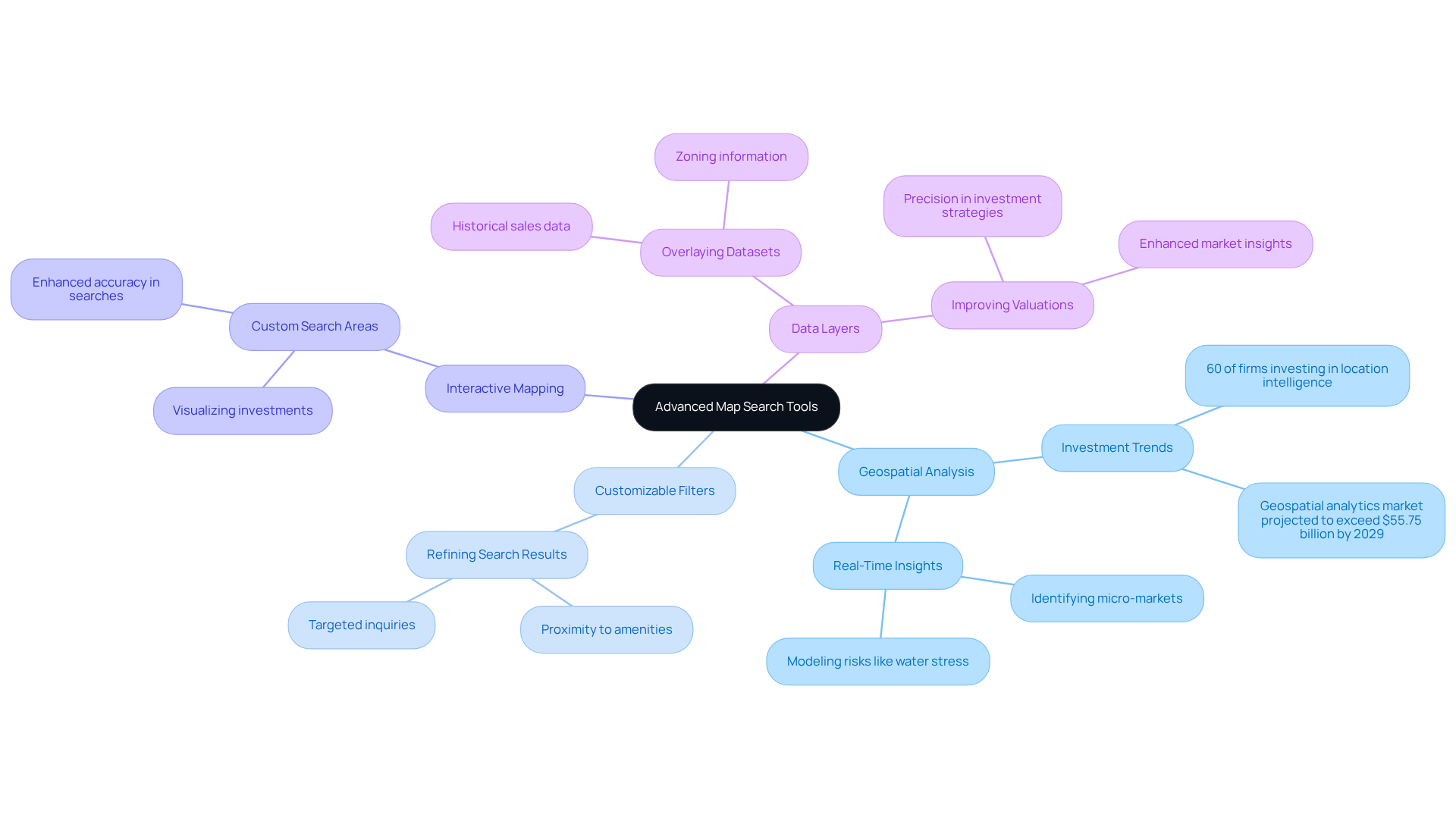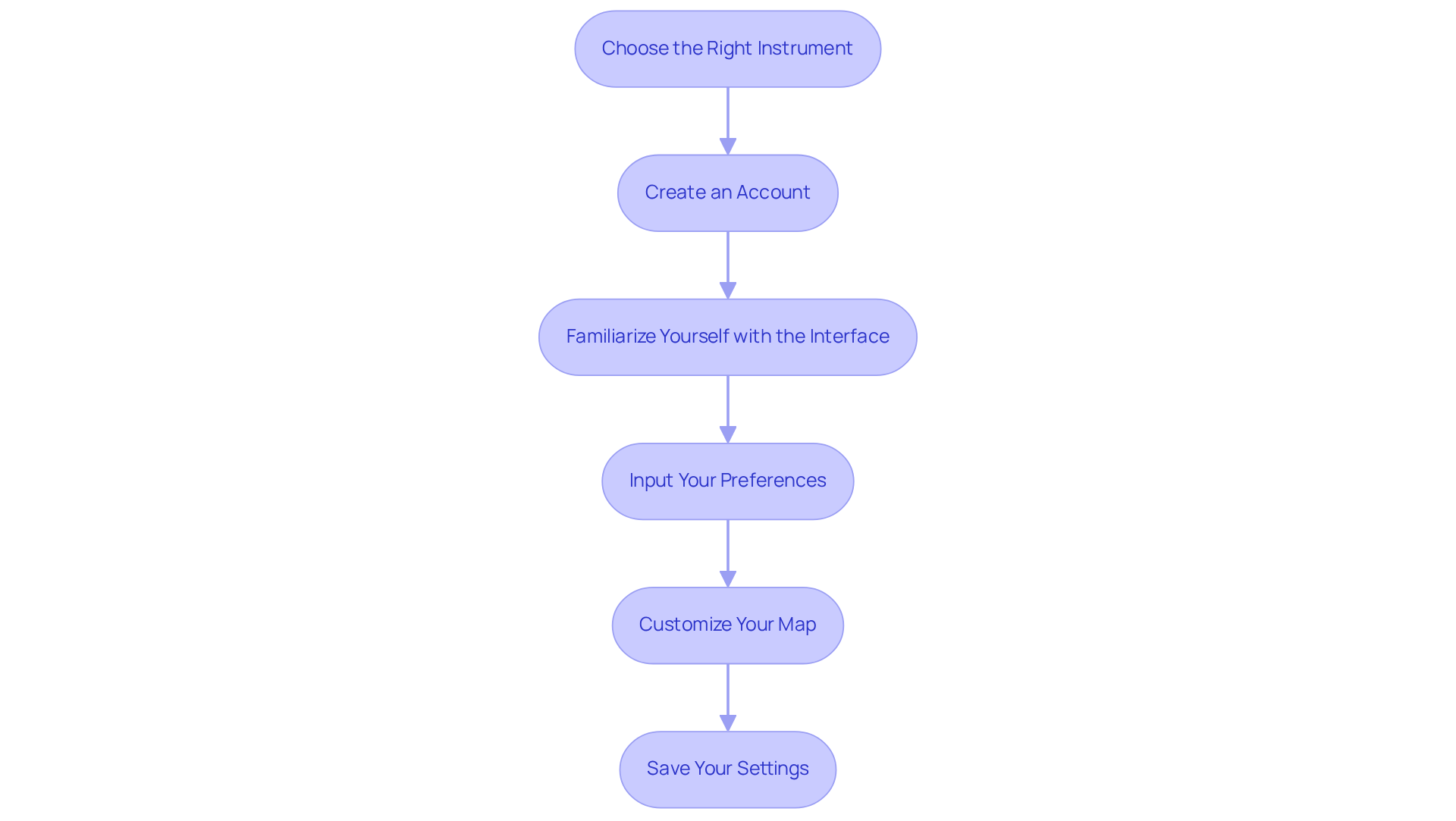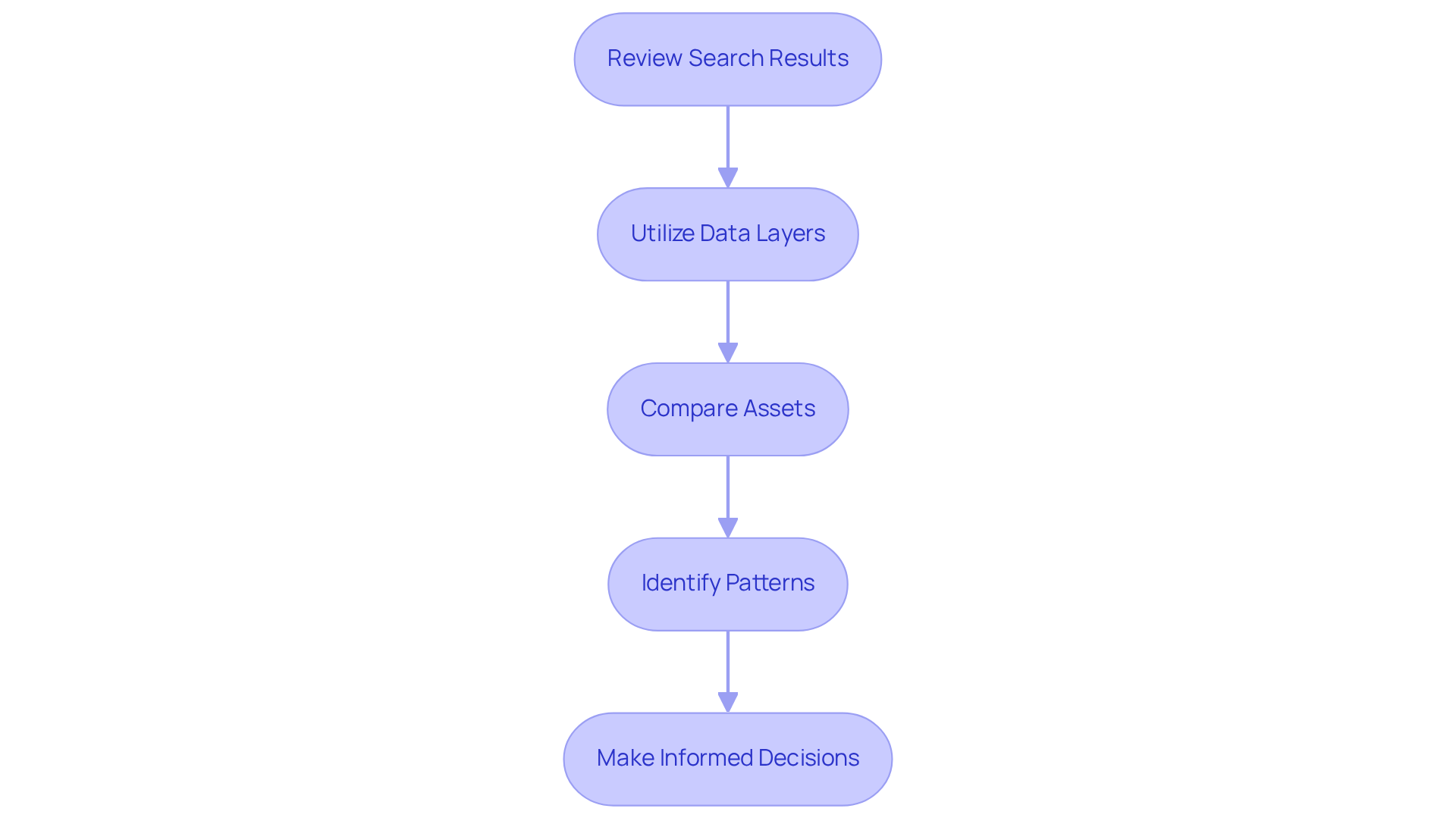Overview
This article underscores the critical importance and effective utilization of advanced map search tools for real estate researchers. It highlights essential features such as:
- Geospatial analysis
- Customizable filters
- Interactive mapping
Furthermore, it elaborates on how these tools significantly enhance research capabilities, facilitate informed decision-making, and improve user engagement through data-driven strategies. Consequently, this underscores their growing significance within the real estate sector.
Introduction
Advanced map search tools are revolutionizing the way real estate researchers navigate the complexities of property data. By leveraging sophisticated geospatial analysis and customizable filters, these tools empower professionals to uncover valuable insights that drive strategic decision-making. Furthermore, as the landscape of real estate continues to evolve, it is crucial for researchers to effectively harness these technologies. This approach will enable them to stay ahead of the competition and make informed choices.
Understand Advanced Map Search Tools in Real Estate Research
Advanced map search tools for real estate researchers are essential for enhancing the real estate research process, providing sophisticated interactive and detailed visual representations of real estate information. These instruments empower users to search for properties based on various criteria, such as location, price range, and property type. Key features include:
- Geospatial Analysis: By utilizing geographic information systems (GIS), these tools analyze spatial data, enabling researchers to identify trends and opportunities in specific areas. Notably, over 60% of real estate firms are investing in location intelligence, acknowledging its potential to enhance decision-making. Furthermore, the geospatial analytics market is projected to exceed $55.75 billion by 2029, underscoring the growing significance of this field.
- Customizable Filters: Users can apply filters to refine results according to specific needs, such as proximity to schools, parks, or public transport, facilitating targeted inquiries that align with client requirements.
- Interactive Mapping: Many tools allow users to create custom search areas on the map, which facilitates more accurate real estate searches. This capability is crucial as it enables real estate professionals to visualize potential investments effectively.
- Data Layers: Users can overlay various datasets, including zoning information, land boundaries, and historical sales data, to gain deeper insights into the market. This integration of data enhances the precision of real estate valuations and investment strategies.
The importance of geospatial analysis in real estate property research cannot be overstated. It not only aids in identifying micro-markets but also supports informed decision-making by providing real-time insights into market dynamics. For instance, a residential developer in Phoenix employed geospatial analytics to model water stress risks across potential development sites, leading to land acquisition strategies that emphasized water efficiency. Consequently, this resulted in developments with 40% lower water consumption than market averages. As the sector transitions to data-driven strategies, utilizing advanced map search tools for real estate researchers will be crucial for professionals seeking to remain competitive in a rapidly changing environment.

Set Up Your Advanced Map Search Tool
To effectively set up your advanced map search tool, consider the following steps:
-
Choose the Right Instrument: Select a mapping instrument that aligns with your specific needs. Options such as Mapbox, Google Maps Platform, and specialized real estate mapping software are popular among professionals. For instance, Google Maps Platform provides up to 100,000 calls at no cost per SKU per month, making it a cost-effective option for many users.
-
Create an Account: Most mapping applications require account creation. Provide the necessary information and verify your email to get started.
-
Familiarize Yourself with the Interface: Take time to explore the system's interface. Utilize available tutorials or guides to understand its features and functionalities.
-
Input Your Preferences: Set your inquiry parameters, including location, property types, and price ranges. This customization will assist the system in producing more pertinent outcomes tailored to your requirements. Notably, research duration can be reduced by fifty percent when isolating elements like pools or garages with a single keyword query.
-
Customize Your Map: Leverage the tool's features to enhance your map. Incorporating layers, markers, and filters can significantly improve your exploration experience and efficiency. For example, using geo decoding and various map fields can help you pinpoint specific locations more effectively.
-
Save Your Settings: After adjusting your preferences, save your settings to ensure they are applied in future queries, streamlining your workflow.
By following these steps, you will be well-prepared to utilize advanced map search tools for real estate researchers effectively, thereby enhancing your research capabilities and improving user engagement in your real estate endeavors. Furthermore, understanding how to plot coordinates on a map is crucial for visualizing geospatial datasets, which can further enhance your analysis.

Analyze and Interpret Data from Map Searches
After conducting a map search with advanced map search tools for real estate researchers, the next crucial step is to analyze and interpret the gathered data effectively. Here’s a structured approach to enhance your analysis:
- Review Search Results: Begin by examining the characteristics that align with your criteria. Pay attention to essential details such as price, square footage, and overall condition of the asset.
- Utilize Data Layers: Leverage the capabilities of your mapping application by enabling various data layers. This will provide valuable insights into neighborhood demographics, crime rates, and school ratings, which are critical for understanding the area.
- Compare Assets: Utilize the mapping instrument to perform side-by-side evaluations of several assets. Look for trends in pricing and features that could influence your purchasing decision.
- Identify Patterns: Analyze the data for emerging patterns, such as price fluctuations over time or the influence of nearby amenities on real estate values. Recognizing these trends can provide a competitive edge.
- Make Informed Decisions: Utilize your analysis to guide your next steps, whether that involves making an offer, conducting further research, or consulting with a real estate professional.
By mastering these data analysis techniques and utilizing advanced map search tools for real estate researchers, you can significantly enhance your effectiveness as a real estate researcher, leading to more informed and strategic decisions.

Troubleshoot Common Issues in Map Searches
Even the most advanced mapping tools can encounter challenges. It is essential to address these common issues with effective troubleshooting strategies to enhance your experience.
-
Map Not Loading: If the map fails to load, first verify your internet connection and refresh the page. If the issue persists, clear your browser cache to eliminate any stored data that may be causing conflicts.
-
Inaccurate Search Results: Ensure that your filters are correctly set. Double-check the criteria entered to avoid missing relevant features, as even minor discrepancies can lead to significant differences in results.
-
Overlapping Markers: When several attributes cluster together, zoom in to view individual markers. Adjusting the map settings to modify marker styles can also help distinguish between properties.
-
Outdated Data: If you encounter outdated information, verify that the mapping application is connected to real-time data sources. Certain instruments may require manual updates to display the latest information.
-
Technical Support: For ongoing problems, consult the application’s help section or contact customer support for assistance. Engaging with support can often resolve complex problems quickly.
By proactively addressing these common issues, you can significantly enhance your experience with advanced map search tools, ensuring efficient and accurate real estate research.

Conclusion
Mastering advanced map search tools is essential for real estate researchers who seek to enhance their research capabilities and make informed decisions. These tools not only offer sophisticated visual representations of properties but also integrate critical data layers that foster a deeper understanding of market dynamics. By leveraging geospatial analysis, customizable filters, and interactive mapping features, users can streamline their search processes and uncover valuable insights that drive strategic real estate investments.
The article underscores the significance of these tools, highlighting their ability to analyze spatial data and identify trends, alongside a step-by-step guide for setting up and troubleshooting common issues with map searches. The importance of effectively analyzing and interpreting data is also emphasized, demonstrating how these practices can lead to more informed decision-making and a competitive edge in the real estate market.
In conclusion, embracing advanced map search tools is not merely an option but a necessity for real estate professionals aiming to thrive in a data-driven environment. By adopting these technologies and mastering their functionalities, researchers can elevate their analysis, enhance their operational efficiency, and ultimately achieve better outcomes in their real estate endeavors. The future of real estate research lies in the hands of those willing to harness the power of advanced mapping tools and data analytics.
Frequently Asked Questions
What are advanced map search tools in real estate research?
Advanced map search tools are sophisticated instruments that enhance the real estate research process by providing interactive and detailed visual representations of real estate information. They allow users to search for properties based on various criteria like location, price range, and property type.
How does geospatial analysis benefit real estate research?
Geospatial analysis utilizes geographic information systems (GIS) to analyze spatial data, helping researchers identify trends and opportunities in specific areas. This analysis supports informed decision-making and is increasingly recognized by real estate firms, with over 60% investing in location intelligence.
What are customizable filters in advanced map search tools?
Customizable filters allow users to refine search results according to specific needs, such as proximity to schools, parks, or public transport. This feature facilitates targeted inquiries that align with client requirements.
What is interactive mapping in real estate research tools?
Interactive mapping enables users to create custom search areas on the map, facilitating more accurate real estate searches and allowing professionals to visualize potential investments effectively.
What types of data can users overlay with advanced map search tools?
Users can overlay various datasets, including zoning information, land boundaries, and historical sales data. This integration enhances the precision of real estate valuations and investment strategies.
Why is geospatial analysis important in real estate property research?
Geospatial analysis is crucial as it aids in identifying micro-markets and provides real-time insights into market dynamics, which supports informed decision-making.
Can you give an example of how geospatial analytics has been applied in real estate?
A residential developer in Phoenix used geospatial analytics to model water stress risks across potential development sites, leading to land acquisition strategies focused on water efficiency. This resulted in developments with 40% lower water consumption than market averages.
What is the projected growth of the geospatial analytics market?
The geospatial analytics market is projected to exceed $55.75 billion by 2029, highlighting the growing significance of this field in real estate and other sectors.




